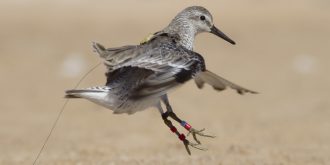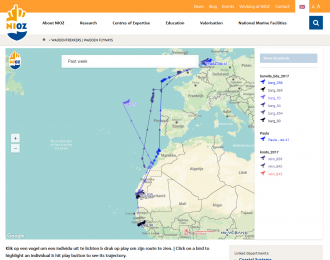New bird-watching: Track & Trace migrating birds with featherlight satellite-transmitters

A handful of red knots with the tiniest transmitters on their backs have left Mauritania, where they spent the winter, and are now heading north. For the first time, the cutting-edge solar-powered transmitters allow scientists to track and trace the exact whereabouts of these small shorebirds migrating from Africa to the Arctic. The birds are expected to stop over to feed in the Wadden Sea, the plentiful mudflats on the Dutch-German-Danish coast that fall dry during low tide. Professor Theunis Piersma, bird migration ecologist at the Royal Netherlands Institute for Sea Research (NIOZ) and University of Groningen, hopes to find out how each bird uses the various ecosystems on its route. The data could unveil whether and how the birds’ behaviours are affected by human wadden systems management and climate change.

Red knot with satellite transmitter just released at Banc d’Arguin, Mauritania (photo: Benjamin Gnep).
Unburdenend by featherlight transmitters
In January, the birds were equipped with the lightest satellite transmitters currently available: only two grams, including battery and solar panel. Apparently unburdened, the birds immediately surprised the scientists by moving around at far longer distances across their winter habitats than previously thought based on the well-known method of colour-ring observations.
Interconnected ecosystems and climate change
Theunis Piersma, the leader of this project, hopes that these ‘satellite knots’ will show the connections between West Africa, the North-West-European Wadden Sea and the breeding areas in Siberia. ‘Now that the transmitters have become so light that even knots can fly with it, we can see in unprecedented detail how the birds make use of all these interconnected areas. They can show us how changes in one area affect ecosystems elsewhere. In our rapidly changing world it is extremely valuable that this advanced technology allows us to collect this vital information as soon as possible.’
Join the birds online
The general public can follow the movements of the birds across the globe on the website www.waddenflyways.nl. Which birds make it to their breeding grounds and back and how do they do it? The comments of scientists along the route are made available via blogs on the website.
Map with live tracking-data and blogs:

Map with live tracking-data and blogs at https://www.nioz.nl/en/waddenflyways
More information:
Kim Sauter, head of communications NIOZ, kim.sauter@nioz.nl 00 31 6 25 32 60 70
Theunis Piersma, bird migration ecologist NIOZ, theunis.piersma@nioz.nl
April 24th 2017
Featured photo: Recently sat-tagged red knot in Mauretania, West-Africa | Picture: Benjamin Gnep
